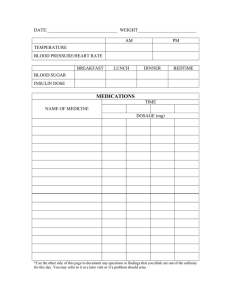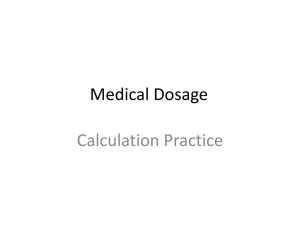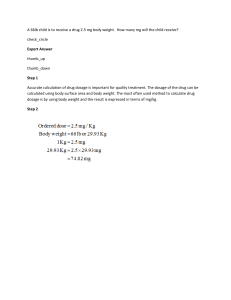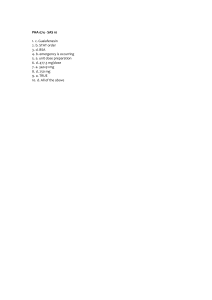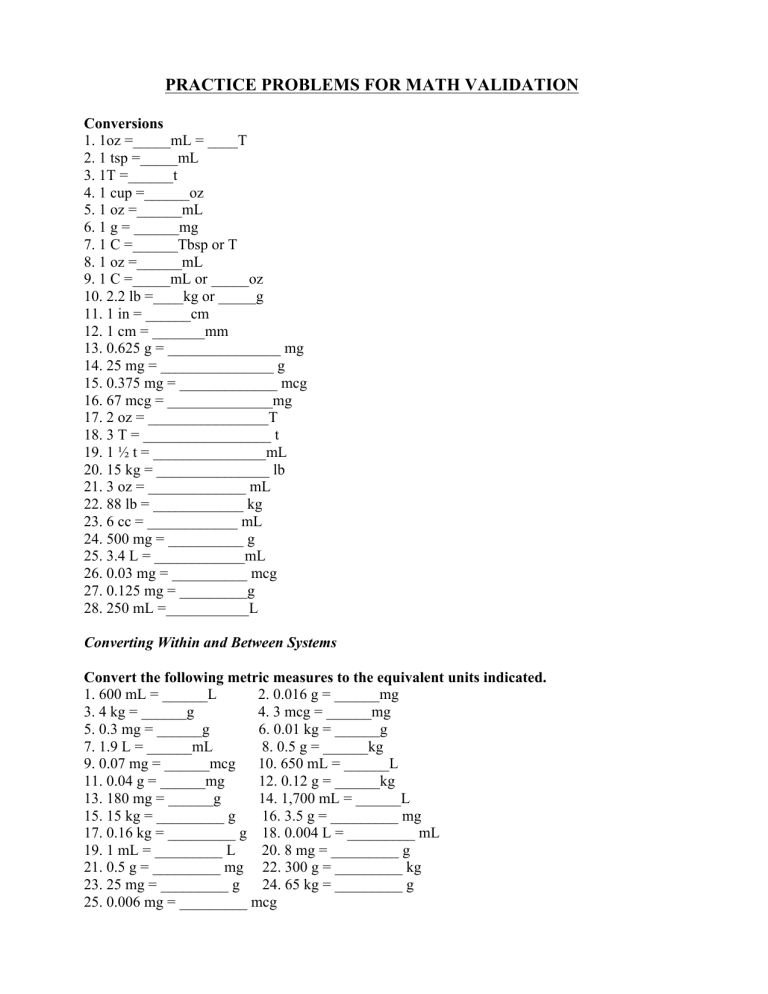
PRACTICE PROBLEMS FOR MATH VALIDATION Conversions 1. 1oz =_____mL = ____T 2. 1 tsp =_____mL 3. 1T =______t 4. 1 cup =______oz 5. 1 oz =______mL 6. 1 g = ______mg 7. 1 C =______Tbsp or T 8. 1 oz =______mL 9. 1 C =_____mL or _____oz 10. 2.2 lb =____kg or _____g 11. 1 in = ______cm 12. 1 cm = _______mm 13. 0.625 g = _______________ mg 14. 25 mg = _______________ g 15. 0.375 mg = _____________ mcg 16. 67 mcg = ______________mg 17. 2 oz = ________________T 18. 3 T = _________________ t 19. 1 ½ t = _______________mL 20. 15 kg = _______________ lb 21. 3 oz = _____________ mL 22. 88 lb = ____________ kg 23. 6 cc = ____________ mL 24. 500 mg = __________ g 25. 3.4 L = ____________mL 26. 0.03 mg = __________ mcg 27. 0.125 mg = _________g 28. 250 mL =___________L Converting Within and Between Systems Convert the following metric measures to the equivalent units indicated. 1. 600 mL = ______L 2. 0.016 g = ______mg 3. 4 kg = ______g 4. 3 mcg = ______mg 5. 0.3 mg = ______g 6. 0.01 kg = ______g 7. 1.9 L = ______mL 8. 0.5 g = ______kg 9. 0.07 mg = ______mcg 10. 650 mL = ______L 11. 0.04 g = ______mg 12. 0.12 g = ______kg 13. 180 mg = ______g 14. 1,700 mL = ______L 15. 15 kg = _________ g 16. 3.5 g = _________ mg 17. 0.16 kg = _________ g 18. 0.004 L = _________ mL 19. 1 mL = _________ L 20. 8 mg = _________ g 21. 0.5 g = _________ mg 22. 300 g = _________ kg 23. 25 mg = _________ g 24. 65 kg = _________ g 25. 0.006 mg = _________ mcg Convert the following measures to the equivalent units indicated. 26. 500 mL = ______L 27. 4 kg = ______g 28. 1.4 L = ______mL 29. 45 mL = ______oz 30. 4.5 mg = ______mcg 31. 3½ oz = ______mL 32. 6.5 L = ______mL 33. 60 g = ______kg 34. 600 mg = _________ g 35. 0.736 mg = _________ mcg 36. 1,600 mL = _________ L 37. 0.015 L = _________ mL 38. 0.18 g = _________ mg 39. 25 mcg = _________ mg 40. 5.2 g = _________ kg Convert the following to the equivalent measures indicated. 41. 60 lb = ______kg 42. 5 oz = ______mL 43. 7 oz = ______mL 44. 45 mL = ______tbs 45. 20 mL = _________ tsp 46. 72 kg = _________ lb 47. 2.4 L = _________ mL Pounds and kilograms conversions (Round to tenths) 1. 22 lb = ________ kg 2. 37 lb = ________ kg 3. 4.8 kg = ________ lb 4. 13 kg = ________ lb 5. 72 kg = ________ lb Convert the following times to military (computer) time 1. 2. 3. 4. 8:02 AM = ___________ 10:57 PM = ___________ 6:45 PM = ____________ 3:30 AM = ____________ Convert the following times to traditional time 1. 2. 3. 4. 1645 = __________ 2230 = __________ 0610 = ___________ 1320 = ___________ Convert the following temperatures from Celsius to Fahrenheit F = 1.8(C) + 32 1. 2. 3. 4. 37.5 C = _______ F 45 C = _______ F 20 C = _______ F 15 C = _______ F Convert the following temperatures from Fahrenheit to Celsius C = (F – 32) / 1.8 1. 2. 3. 4. 68 F = _______ C 50 F = _______ C 99.5 F = ______ C 100.4 F = ______ C Simple Dosage Calculations 1. You need to administer prochlorperazine (Compazine) 10 mg IM to a nauseated patient. You have on hand Compazine 5 mg/mL. How should you prepare the correct dose? 2. An order reads furosemide (Lasix) 40 mg IV push. You have on hand 20 mg/2 mL. How should you prepare the correct dose? 3. You have on hand diazepam (Valium) 5 mg/mL. You need to administer 8 mg IV push stat. to a patient having a seizure. How much should you draw into the syringe? 4. Your patient is to receive metoprolol tartrate (Lopressor) 25 mg PO daily. The pharmacist dispenses 50 mg scored tablets. How many should your patient take each day? 5. A home care patient must restrict fluid intake to 2 L every 24 hours. He has only household measuring cups. How many cups may he drink daily and not exceed the 2 L limit? 6. Your order reads penicillin 1.2 million units IM daily. You have penicillin 500,000 units/mL. How should you prepare the correct dose? 7. Your order reads labetalol 40 mg IV push every 10 minutes until blood pressure is lower than 140/90 mm Hg. You have labetalol 5 mg/mL available. How should you prepare the correct dose? 8. You have on hand ergocalciferol liquid 8,000 units/2 mL. Your order reads ergocalciferol 225,000 units PO daily. How should you prepare the correct dose? (Do Not Round) 9. Your order reads ergocalciferol 225,000 units PO daily. You have on hand ergocalciferol in 50,000 unit tablets. How many do you administer? 10. Your order reads cortisone 15 mg PO every morning. You have on hand cortisone 10 mg tablets. How should you prepare the correct dose? 11. Amoxil (amoxicillin) suspension 180 mg PO bid is ordered for a patient who cannot swallow pills. It is supplied as 125 mg/5 mL. How many milliliters should you administer? 12. Diltiazem (Cardizem) 90 mg PO tid is ordered for a patient with hypertension. It is supplied in 60 mg scored tablets. How many tablets should you administer? 13. Atropine 0.6 mg IM is ordered preoperatively. It is supplied as 0.4 mg/mL. How many milliliters should you administer? 14. Each acetaminophen (Tylenol) #3 tablet has 325 mg of acetaminophen and 30 mg codeine. A patient is told to take 2 tablets PO every 4 hours for pain. The maximum safe dose of acetaminophen is 4 g/day. The safe dose of codeine varies with tolerance. Is the dose safe? 15. A patient is taking acetaminophen (Tylenol) 325 mg, 2 tablets PO every 6 hours. How many grams is the patient receiving in 24 hours? 16. You have an order for diphenhydramine hydrochloride (Benadryl) 40 mg IM ASAP. You have on hand Benadryl 25 mg/mL. How many milliliters do you prepare? 17. You have digoxin (Lanoxin) 0.25 mg tablets, and you need to administer 0.375 mg PO. How many tablets should you administer? 18. Phenobarbital is supplied as 60 mg/mL. You need to administer 160 mg IV stat. How many milli- liters should you administer? (Round to nearest tenths) 19. You have an order for furosemide (Lasix) 80 mg IV every morning. You have on hand Lasix 20 mg in 2 mL sterile water. How many milliliters should you prepare? 20. You need to administer 40 mg of furosemide (Lasix) PO. You have on hand Lasix 20 mg tablets. How many tablets should you give? 21. You have an order for heparin 3000 units SC every 12 hours. You have available 5,000 units/mL. How many milliliters will you give? 22. A patient is sent home on captopril (Capoten), 6.25 mg PO bid. Her pharmacist dispenses 25 mg scored tablets. How many tablets should the patient take for each dose? 23. You have an order for Phenobarbital 50 mg PO at bedtime. It is supplied as Phenobarbital elixir 20 mg/5 mL. How much will you administer? 24. You need to administer lorazepam (Ativan) 3 mg IM to an agitated patient. You have on hand 4 mg/mL. How much do you prepare? (Do Not Round) 25. You need to administer 125 mg of methylprednisolone sodium succinate (SoluMedrol) IV push bid to a patient with acute exacerbation of chronic obstructive pulmonary disease. You have on hand 40 mg/mL. How much do you prepare? (Round to nearest tenths) 26. A patient has a bottle of warfarin (Coumadin) 5 mg tablets at home. After his most recent international normalized ratio (INR), the doctor calls and tells him to take 7.5 mg/day. How many tables should the patient take? 27. You have on hand penicillin 300,000 units/mL. Your order reads penicillin 1,000,000 units IM. How will you fill the syringe? (Round to nearest tenths) 28. The physician orders alprazolam (Xanax) 0.5 mg PO. You have on hand Xanax 0.25 mg tablets. How many will you give? 29. You need to administer 250 mg of erythromycin PO. You have on hand 0.5 g tablets. How many tablets will you give? 30. You need to administer 400 mg of erythromycin PO. You have on hand a suspension of 125 mg/5 mL. How much will you prepare? 31. The physician orders meperidine 75 mg IM every 4 to 6 hours prn for a patient admitted with acute cholecystitis. You have on hand meperidine 50 mg/mL. How much will you give? 32. A patient is receiving 60 mg of methylprednisolone IM every 8 hours. You have on hand 75 mg/mL. How much will you draw up? 33. Your patient has a headache but has difficulty swallowing pills. The physician orders acetaminophen 1000 mg PO every 4 to 6 hours prn. You have acetaminophen elixir 160 mg in 5 mL. How much will you administer? (Do Not Round) 34. A patient is admitted to the emergency room with a fractured leg. The physician orders morphine 15 mg IM stat. You have on hand morphine 10 mg/mL. How many milliliters will you administer? 35. A patient is receiving 160 mg of methylprednisolone IM every 12 hours. You have on hand two vials that each contains 125 mg/2 mL. How much will you draw into a syringe? (Round to nearest tenths) 36. You have available lorazepam (Ativan) 0.5 mg tablets, and you need to administer 1 mg PO. How many tablets will you administer? 37. A patient is instructed to take acetaminophen (Tylenol) liquid (elixir) 650 mg qid. The elixir is 160 mg/5 mL. How many milliliters per dose should the patient take? (Round to nearest whole number) 38. The physician writes a “now” order for codeine 45 mg IM for a patient with a vertebral compression fracture. You have on hand codeine 60 mg/2 mL. How many milliliters should you give? 39. A patient with heart failure has a daily order for digoxin 0.25 mg PO. Digoxin 0.125 mg tablets are available. How many tablets should you give? Simple Dosage Calculations and Labels 1. Order: Zantac 300 mg po daily at bedtime. Available: Dosage: ____________________ 2. Order: Evista 60 mg po daily. Available: Dosage: ___________________ 3. Order: Tegretol 0.3 g po bid. Available: Dosage: ___________________ 4. Order: Kefzol 850 mg IM q6h. Available: How many milliliters will you administer? (Round to nearest tenths) ___________________ mL Interpreting Labels 1. Trade name: ____________________ Generic name: ____________________ Dosage strength: ____________________ Form: ____________________ Total amount in container: ____________________ 2. Trade name: ____________________ Generic name: ____________________ Dosage strength: ____________________ According to the label, who should not use this medication? ____________________ 3. Trade name: ____________________ Generic name: ____________________ Dosage strength: ____________________ Form: ____________________ Total amount in container: ____________________ Calculating BSA 1. The normal adult dosage is 10 to 20 mg. BSA = 0.74m2. What is the dosage range? (Round to tenths) 𝐵𝑆𝐴 𝑚2 𝑥 𝑎𝑑𝑢𝑙𝑡 𝑑𝑜𝑠𝑒 1.7 (𝑚2) 2. A child’s BSA is 0.94m2. The recommended adult dosage is 15mg. What will the child’s dosage be? (Round to tenths) 𝐵𝑆𝐴 𝑚2 𝑥 𝑎𝑑𝑢𝑙𝑡 𝑑𝑜𝑠𝑒 1.7 (𝑚2) Intake and Output 1. A client's intake was the following: 3/4 cup of coffee (cup = 8 oz) 1 can of ginger ale (1 can = 12 oz) 1/2 glass of cranberry juice (glass = 6 oz) How many milliliters will you record on the intake and output (I&O) sheet? _____________ mL 2. Calculate the fluid intake in milliliters (mL) for the following meal. (Assume a cup = 6 oz and a glass = 8 oz) 1/3 glass orange juice 1/2 cup tea 1/2 pt milk 1 tuna fish sandwich 1 Popsicle (3 oz) TOTAL = ________ mL Sliding Scale Insulin 1. Order: Humulin NPH 40 units and Humulin Regular 25 units SC every morning. The AM finger-stick blood sugar is 213mg/dL. What is the total number of units to be administered? Use the sliding scale below. ________ units Blood Sugar 0-180 181-200 201-220 221-240 > 240 Regular Insulin 0 units 2 units 4 units 6 units Call physician Practice Dosage Calculations Insulin and Heparin IV Therapy 1. Order: Regular insulin 7 units/hr IV 2. Order: Regular insulin 18 units/hr IV Available: Regular insulin 50 units in 250 mL NS The IV flow rate to deliver this dosage is _______________.: Available: Regular insulin 100 units in 100 mL NS The IV flow rate to deliver this dosage is _______________. 3. Order: Regular insulin 10 units/hr IV 4. Order: Regular insulin 12 units/hr IV Available: Regular insulin 100 units in 250 mL NS The IV flow rate to deliver this dosage is _______________. Available: Regular insulin 150 units in 150 mL NS The IV flow rate to deliver this dosage is _______________. 5. Order: Regular insulin 12 units/hr IV 6. Order: Heparin 1200 units/hr Available: Regular insulin 50 units in 100 mL NS The IV flow rate to deliver this dosage is _______________. Available: Heparin 50,000 units in 500 mL NS The IV flow rate is _______________. 7. Order: Heparin 1800 units/hr 8. Order: Heparin 1700 units/hr Available: Heparin 25,000 units in 500 mL NS The IV flow rate is _______________. Available: Heparin 25,000 units in 500 mL 1/2 NS The IV flow rate is _______________. 9. Order: Heparin 1100 units/hr 10. Order: Heparin 1000 units/hr Available: Heparin 50,000 units in 500 mL D5W The IV flow rate is _______________. Available: Heparin 20,000 units in 500 mL D5W The IV flow rate is _______________. 11. Order: Heparin 1450 units/hr 12. Order: Heparin 1600 units/hr Available: Heparin 25,000 units in 500 mL D5W The IV flow rate is _______________. Available: Heparin 25,000 units in 250 mL D5 1/2 NS The IV flow rate is _______________. 13. Order: D5W 1,000 mL IV with heparin 40,000 Units to infuse at 40 mL/h. What is the hourly heparin dosage? 14. Order: D5W 500 mL IV with heparin 5,000 Units to infuse at 80 mL/h. What is the hourly heparin dosage? 15. Order: D5W 1 L IV with heparin 40,000 Units to infuse at 30 mL/h. What is the hourly heparin dosage? Practice Dosage Calculations IV Therapy (Round to nearest whole number) 1. Infuse 1 L of NS in 8 hours: 2. Infuse 250 mL packed cells in 3 hours: 3. Infuse 1500 mL of 0.45% NS in 16 hours: 4. Infuse Intralipid 20% 500 mL in 10 hours: 5. Infuse 1,000 mL D5W in 13 hours: 6. Infuse 1 L of NS in 4 hours: 7. Infuse 1 L LR in 7 hours: 8. Infuse 1,000 mL in 15 hours: 9. Infuse 2,000 mL D5W in 20 hours: 10. Infuse 0.5 L D5LR in 8 hours: 11. Infuse 1,000 mL Ringer’s lactate in 12 hours. Drop factor is 15 gtt/mL. 12. Infuse 500 mL ½ NS in 12 hours with microdrip tubing: 13. Infuse 1,000 mL D5W in 8 hours. Drop factor is 20 gtt/mL: 14. Infuse 1 L NS in 10 hours. Drop factor is 15 gtt/mL: 15. Infuse I L D5W at 125 mL/hr. Drop factor is 10 gtt/mL: 16. Infuse 1 L LR at 200 mL/hr. The drop factor is 10 gtt/mL 17. Infuse 1 L NS at 80 mL/hr. Drop factor is 20 gtt/mL 18. Infuse 1 L D5W at 150 mL/hr. Drop factor is 20 gtt/mL 19. The doctor orders the following IVs for 12 hours: (1) 500 mL D5NS with 1 ampule MVI (multivitamins); (2) 250 mL D5W. The drop factor is 10 gtt/mL. What is the infusion rate in gtt/min for both fluids? 20. The doctor orders the following IVs for 24 hours to infuse at 80 mL/hr: (1) 1 L D5W with 20 mEq KCL; (2) 0.5 L NS; (3) 0.5 L LR. The drop factor is 15 gtt/mL. What is the flow rate in gtt/min? Practice Pediatric Dosage Calculations (Round Final Answer to the nearest tenths) 1. The recommended dosage of kanamycin is 15 mg/kg/day q8h. The child weighs 25 kg. The amount for one dose is _______________. 2. The recommended initial dose of mercaptopurine is 1.5 mg/kg/day p.o. The recommended daily dosage for a child weighing 44 lb is _______________. 3. The recommended dosage of IV vancomycin is 40 mg/kg/day divided q6h. The child weighs 35 kg. The amount for one dose is _______________. 4. The recommended dosage of amoxicillin is 20 mg/kg/day in divided doses q8h. The child weighs 11 lb. The total daily dose is _______________. 5. The recommended dosage of erythromycin suspension is 20 mg/kg/day in four equally divided doses. The child weighs 44 lb. How many milligrams are needed for each individual dose? _______________. 6. The recommended dosage of oxacillin is 25 mg/kg/day to be administered q6h. The child weighs 5 lb 8 oz. The total daily dose would be _______________. 7. The recommended pediatric IV dosage of furosemide is 1 mg/kg not to exceed 6 mg/kg. The child weighs 55 lb. Available: Furosemide 20 mg/2 mL. How many mL will the child receive? _______________. 8. The normal adult dose of a drug is 5 to 15 mg. The dose for a child whose BSA is 0.95 m2 is _______________. 9. The average adult dose of a drug is 20 mg. The dose for a child whose BSA is 0.87 m2 is _______________. 10. The average adult dose of a drug is 25 mg. The dose for a child whose BSA is 0.98 m2 is _______________. 11. The adult dose of a drug is 125 mg. The dose for a child whose BSA is 0.16 m2 is _______________. 12. The adult dose of a drug is 15 mg. The dose for a child whose BSA is 0.34 m2 is _______________. 13. The adult dose of a drug is 500 mg. The dose for a child whose BSA is 0.57 m2 is _______________. 14. The recommended children's dosage of Keflex is 25 to 50 mg/kg/day in divided doses. The safe dosage range for a child weighing 42 lb is _______________. 15. The recommended dosage of clindamycin oral suspension is 8 to 25 mg/kg/day in four divided doses. The child weighs 30 kg. The maximum dose for 24 hours is _______________. 16. The recommended children's dose is 3 to 5 mg/kg/day q12h. The child weighs 9 lb. What is the safe dose per day? What is the safe dose per dose? 17. The recommended digitalizing dose of digoxin elixir for children 2 to 5 years old is 30 to 40 mcg/kg. Half of the digitalizing dose is to be given immediately, and the remainder is to be divided into two doses, which are to be given at 8-hour intervals. The child weighs 48 lb. The first dose will fall in the range of _______________. 18. The recommended daily dosage for an infant is 0.035 to 0.06 mg/kg/day in divided doses q8h. The safe dosage range for an infant weighing 6 1/2 lb is _______________. 19. Order: Amantadine HCl 35 mg p.o. t.i.d. The recommended pediatric dosage of amantadine is 4.4 to 8.8 mg/kg/day p.o. in three divided doses not to exceed 200 mg/day. The order is safe for a 35-lb child because the child's daily dose is _______________. 20. The recommended dosage of Narcan for a child is 0.005 to 0.01 mg/kg q2-3min p.r.n. A safe effective dose for a child weighing 110 lb is _______________. ANSWERS -­‐ Practice Packet for Math Validation Conversions 1. 2. 3. 4. 5. 6. 7. 8. 9. 10. 11. 12. 13. 14. 15. 16. 17. 18. 19. 20. 21. 22. 23. 24. 25. 26. 27. 28. 30, 2 5 3 8 30 1,000 16 30 240, 8 1; 1,000 2.5 10 625 0.025 375 0.067 4 9 7.5 33 90 40 6 0.5 3,400 30 0.000125 0.25 Converting Within and Between Systems 1) 0.6 2) 16 3) 4,000 4) 0.003 5) 0.0003 6) 10 9) 70 10) 0.65 11) 40 12) 0.00012 13) 0.18 7)1,900 8) 0.0005 14) 1.7 15) 15,000 16) 3,500 17) 160 18) 4 19) 0.001 20) 0.008 21) 500 22) 0.3 23) 0.025 24) 65,000 25) 6 26) 0.5 27) 4,000 28)1,400 30) 4,500 31) 105 32) 6,500 33) 0.06 34) 0.6 35) 736 37) 15 38) 180 39) 0.025 40) 0.0052 41) 27.3 42) 150 44) 3 45) 4 47) 2,400 29) 1.5 36) 1.6 43) 210 46) 158.4 Pounds and kilograms conversions 1. 10 2. 16.8 3. 10.6 4. 28.6 5. 158.4 Converting the following times to military (computer) time 1. 2. 3. 4. 0802 2257 1845 0330 Convert the following times to traditional time 1. 2. 3. 4. 4:45 PM 10:30 PM 6:10 AM 1:20 PM Converting Celsius to Fahrenheit 1. 2. 3. 4. 99.5 F 113 F 68 F 59 F Converting Fahrenheit to Celsius 1. 2. 3. 4. 20 C 10 C 37.5 C 38 Simple Dosage Calculations 1. 2. 3. 4. 5. 6. 7. 8. 9. 10. 11. 12. 13. 14. 15. 16. 17. 18. 19. 20. 21. 22. 23. 24. 25. 26. 27. 28. 29. 30. 31. 32. 33. 34. 2 mL 4 mL 1.6 mL ½ tab 8 1/3 or 8.3 cups 2.4 mL 8 mL 56.25 mL 4.5 tabs 1.5 tabs 7.2 mL 1.5 tabs 1.5 mL Yes, total acetaminophen = 3.9 grams per day 2.6 g 1.6 mL 1.5 tabs 2.7 mL 8 mL 2 tabs 0.6 mL ¼ tab 12.5 mL 0.75 mL 3.1 mL 1.5 tabs 3.3 mL 2 tabs ½ tab 16 mL 1.5 mL 0.8 mL 31.25 mL 1.5 mL 35. 36. 37. 38. 39. 2.6 mL 2 tabs 20 mL 1.5 mL 2 tabs Simple Dosage Calculations and Labels 1. 2. 3. 4. 2 tabs 1 tab 3 tabs 2.6 mL Interpreting Labels 1. Trade name: Ambien Generic name: zolpidem tartrate Dosage strength: 5 mg/tab Form: tablets Total amount in container: 100 tabs 2. Trade name: Cytotec Generic name: misoprostol Dosage strength: 100 mcg/tab Not recommended for use: pregnant women 3. Trade name: Detrol LA Generic name: tolterodine tartrate Dosage strength: 2 mg Form: Extended release capsules Total amount in container: 30 capsules Calculating BSA 1. 4.4 to 8.7 mg 2. 8.3 mg Intake and Output 1. 630 mL 2. 510 mL Sliding Scale Insulin 1. 69 units Insulin and Heparin IV Therapy 1. 2. 3. 4. 5. 6. 7. 8. 9. 10. 11. 12. 13. 14. 15. 35 mL/hr 18 mL/hr 25 mL/hr 12 mL/hr 24 mL/hr 12 mL/hr 36 mL/hr 34 mL/hr 11 mL/hr 25 mL/hr 29 mL/hr 16 mL/hr 1600 units/hr 800 units/hr 1200 units/hr IV Therapy 1. 2. 3. 4. 5. 6. 7. 8. 9. 10. 11. 125 mL/hr 83 mL/hr 94 mL/hr 50 mL/hr 77 mL/hr 250 mL/hr 143 mL/hr 67 mL/hr 100 mL/hr 63 mL/hr 21 gtts/min 12. 13. 14. 15. 16. 17. 18. 19. 20. 42 gtts/min 42 gtts/min 25 gtts/min 21 gtts/min 33 gtts/min 27 gtts/min 50 gtts/min 7 gtts/min and 3 gtts/min 20 gtts/min Pediatric Dosage Calculations 1. 2. 3. 4. 5. 6. 7. 8. 9. 10. 11. 12. 13. 14. 15. 16. 17. 18. 19. 20. 125 mg/dose 30 mg/day 350 mg/dose 100 mg/day 100 mg/dose 62.5 mg/day 2.5 mL-­‐15 mL 2.8 mg-­‐8.4 mg 10.2 mg 14.4 mg 11.8 mg 3 mg 167.6 mg 477.3-­‐954.5 mg/day 240-­‐750 mg 12.3-­‐20.5 mg/day and 6.2-­‐10.3 mg/dose 327.3-­‐436.4 mg for half of the dose NOW and 163.7-­‐218.2 mg to be divided into 2 doses 0.1-­‐0.2 mg 70-­‐140 mg/day 0.3-­‐0.5 mg/day
